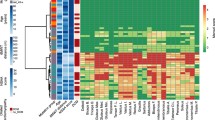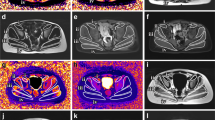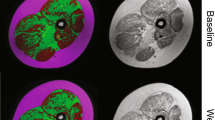Abstract
The purpose of this ethics approved trial was to correlate quantitative MRI with functional abilities in both ambulant and non-ambulant Duchenne muscular dystrophy (DMD). Twenty patients with genetically confirmed DMD were recruited. Physical assessment was performed using the motor function measurement (MFM) scale. Axial 3T MRI scans of the thighs were acquired using T1-weighted in- and opposed-phase images (TR = 20 ms, TE1 = 2.45 ms, TE2 = 3.68 ms, flip angle = 15°) to calculate the relative fat fraction according to the two-point Dixon method in the knee extensors, flexors, and adductor muscles. The average MFM was 65.3 % and correlated negatively to age (r 2 = 0.60). Overall mean fat fraction correlated positively to age (r 2 = 0.51–0.64). An average of 5 % increase in mean fat fraction per year was calculated. Mean fat fraction of the quadriceps showed a high negative correlation (r 2 = 0.93) to the D1 (standing position and transfers) component of the MFM. A cutoff for mean fat fraction of 50 % predicted loss of ambulation with a sensitivity of 100 % and a specificity of 91 %. Therefore, quantitative muscle MRI seems to be a promising endpoint for short clinical trials evaluating the effect of newer treatments on the time of loss of ambulation in DMD.


Similar content being viewed by others
Abbreviations
- DMD:
-
Duchenne muscular dystrophy
- F:
-
Fat
- FF:
-
Fat fraction
- MRI:
-
Magnetic resonance imaging
- MFM:
-
Motor function measurement
- qMRI:
-
Quantitative magnetic resonance imaging
- ROI:
-
Regions of interest
- TE:
-
Echo time
- TR:
-
Repetition time
- W:
-
Water
References
Manzur AY, Muntoni F (2009) Diagnosis and new treatments in muscular dystrophies. J Neurol Neurosurg Psychiatr 80:706–714. doi:10.1136/jnnp.2008.158329
Buyse GM, Goemans N, van den Hauwe M, Thijs D, de Groot IJ, Schara U, Ceulemans B, Meier T, Mertens L (2011) Idebenone as a novel, therapeutic approach for Duchenne muscular dystrophy: results from a 12 month, double-blind, randomized placebo-controlled trial. Neuromuscul Disord 21:396–405. doi:10.1016/j.nmd.2011.02.016
Kinali M, Arechavala-Gomeza V, Feng L, Cirak S, Hunt D, Adkin C, Guglieri M, Ashton E, Abbs S, Nihoyannopoulos P, Garralda ME, Rutherford M, McCulley C, Popplewell L, Graham IR, Dickson G, Wood MJ, Wells DJ, Wilton SD, Kole R, Straub V, Bushby K, Sewry C, Morgan JE, Muntoni F (2009) Local restoration of dystrophin expression with the morpholino oligomer AVI-4658 in Duchenne muscular dystrophy: a single-blind, placebo-controlled, dose-escalation, proof-of-concept study. Lancet Neurol 8:918–928. doi:10.1016/S1474-4422(09)70211-X
Vuillerot C, Girardot F, Payan C, Fermanian J, Iwaz J, De Lattre C, Berard C (2010) Monitoring changes and predicting loss of ambulation in Duchenne muscular dystrophy with the motor function measure. Dev Med Child Neurol 52:60–65. doi:10.1111/j.1469-8749.2009.03316.x
Pichiecchio A, Uggetti C, Egitto MG, Berardinelli A, Orcesi S, Gorni KO, Zanardi C, Tagliabue A (2002) Quantitative MR evaluation of body composition in patients with Duchenne muscular dystrophy. Eur Radiol 12:2704–2709. doi:10.1007/s00330-002-1392-4
Garrood P, Hollingsworth K, Eagle M, Aribisala BS, Birchall D, Bushby K, Straub V (2009) MR imaging in Duchenne muscular dystrophy: quantification of T1-weighted signal, contrast uptake, and the effects of exercise. J Magn Reson Imaging 30:1130–1138. doi:10.1002/jmri.21941
Huang Y, Majumdar S, Genant HK, Chan WP, Sharma KR, Yu P, Mynhier M, Miller RG (1994) Quantitative MR relaxometry study of muscle composition and function in Duchenne muscular dystrophy. J Magn Reson Imaging 4:59–64
Fischmann A, Gloor M, Fasler S, Haas T, Rodoni Wetzel R, Bieri O, Wetzel S, Heinimann K, Scheffler K, Fischer D (2011) Muscular involvement assessed by MRI correlates to motor function measurement values in oculopharyngeal muscular dystrophy. J Neurol 258:1333–1340. doi:10.1007/s00415-011-5937-9
Sinclair C, Morrow J, Fischmann A, Hanna M, Reilly M, Yousry T, Golay X, Thornton J (2011) Skeletal muscle MRI-determined fat fraction and myometric strength in inclusion body myositis and Charcot-Marie-Tooth disease Type 1A. Neuromuscul Disord 21:S5. doi:10.1016/S0960-8966(11)70014-1
Kinali M, Arechavala-Gomeza V, Cirak S, Glover A, Guglieri M, Feng L, Hollingsworth KG, Hunt D, Jungbluth H, Roper HP, Quinlivan RM, Gosalakkal JA, Jayawant S, Nadeau A, Hughes-Carre L, Manzur AY, Mercuri E, Morgan JE, Straub V, Bushby K, Sewry C, Rutherford M, Muntoni F (2011) Muscle histology vs MRI in Duchenne muscular dystrophy. Neurology 76:346–353. doi:10.1212/WNL.0b013e318208811f
Liu GC, Jong YJ, Chiang CH, Jaw TS (1993) Duchenne muscular dystrophy: MR grading system with functional correlation. Radiology 186:475–480
Bérard C, Payan C, Hodgkinson I, Fermanian J, Group MFMCS (2005) A motor function measure for neuromuscular diseases. Construction and validation study. Neuromuscul Disord 15:463–470
Dixon WT (1984) Simple proton spectroscopic imaging. Radiology 153:189–194
Sinclair C, Morrow J, Yousry T, Reilly M, Hanna M, Golay X, Thornton J (2010) Inter-scan reproducibility of quantitative neuromuscular MRI. Neuromuscul Disord 20:S28
Fischmann A, Hafner P, Fasler S, Gloor M, Bieri O, Studler U, Fischer D (2012) Quantitative MRI can detect subclinical disease progression in muscular dystrophy. J Neurol. doi:10.1007/s00415-011-6393-2
Fischmann A, Kaspar S, Reinhardt J, Gloor M, Stippich C, Fischer D (2012) Exercise might bias Skeletal-Muscle Fat Fraction Calculation from Dixon Images. Neuromuscul Disord 22. doi: 10.1016/j.nmd.2012.05.014
Kim HK, Laor T, Horn PS, Wong B (2010) Quantitative assessment of the T2 relaxation time of the gluteus muscles in children with Duchenne muscular dystrophy: a comparative study before and after steroid treatment. Korean J Radiol 11:304–311. doi:10.3348/kjr.2010.11.3.304
Kim HK, Laor T, Horn PS, Racadio JM, Wong B, Dardzinski BJ (2010) T2 mapping in Duchenne muscular dystrophy: distribution of disease activity and correlation with clinical assessments. Radiology 255:899–908. doi:10.1148/radiol.10091547
Janiczek RL, Gambarota G, Sinclair CD, Yousry TA, Thornton JS, Golay X, Newbould RD (2011) Simultaneous T(2) and lipid quantitation using IDEAL-CPMG. Magn Reson Med 66:1293–1302. doi:10.1002/mrm.22916
Gaeta M, Messina S, Mileto A, Vita GL, Ascenti G, Vinci S, Bottari A, Vita G, Settineri N, Bruschetta D, Racchiusa S, Minutoli F (2012) Muscle fat-fraction and mapping in Duchenne muscular dystrophy: evaluation of disease distribution and correlation with clinical assessments: preliminary experience. Skeletal Radiol 41:955–961. doi:10.1007/s00256-011-1301-5
Goutallier D, Postel JM, Bernageau J, Lavau L (1994) Fatty muscle degeneration in cuff ruptures. Pre- and postoperative evaluation by CT scan. Clin Orthop Relat Res 304:78–83
Catlin N, Bettelheim K, Henderson I (2011) Individual patient (n = 1) “trials” in Duchenne dystrophy. Neuromuscul Disord 21:525–526. doi:10.1016/j.nmd.2011.05.003
Aartsma-Rus A (2011) The risks of therapeutic misconception and individual patient (n = 1) “trials” in rare diseases such as Duchenne dystrophy. Neuromuscul Disord 21:13–15. doi:10.1016/j.nmd.2010.09.012
Skinner TE, Glover GH (1997) An extended two-point Dixon algorithm for calculating separate water, fat, and B0 images. Magn Reson Med 37:628–630
Acknowledgments
D.F. was supported by a grant from the Lorenzo-Piaggio Foundation, Switzerland, and the University Children's Hospital, Basel. The sponsors had no influence on study design, data evaluation or publication. The Department of Radiology is supported by a grant from Bracco (Switzerland). The sponsor played no role in matters of design, collection, analysis, interpretation of data and writing of the report. We would like to thank Anthony Tyndall for his help proofreading the manuscript. We also would like to thank the reviewers, whose comments have improved the quality of the manuscript considerably.
Conflicts of interest
The authors declare that they have no conflict of interest.
Ethical standard
This study has been approved by the appropriate ethics committee and has therefore been performed in accordance with the ethical standards laid down in the 1964 Declaration of Helsinki.
Author information
Authors and Affiliations
Corresponding author
Additional information
P. Hafner and A. Fischmann contributed equally to this work.
Rights and permissions
About this article
Cite this article
Fischmann, A., Hafner, P., Gloor, M. et al. Quantitative MRI and loss of free ambulation in Duchenne muscular dystrophy. J Neurol 260, 969–974 (2013). https://doi.org/10.1007/s00415-012-6733-x
Received:
Revised:
Accepted:
Published:
Issue Date:
DOI: https://doi.org/10.1007/s00415-012-6733-x




